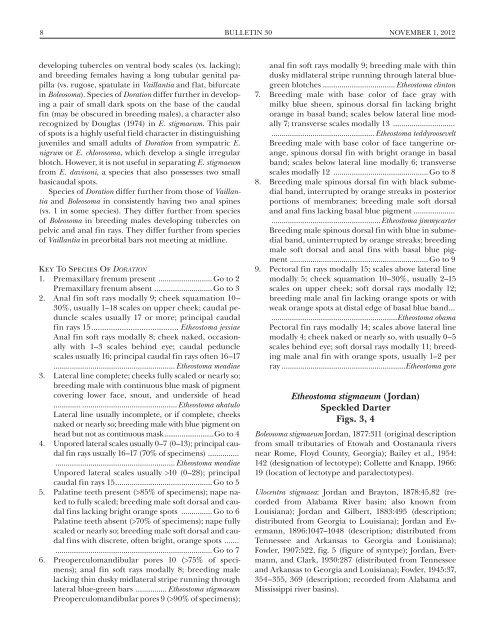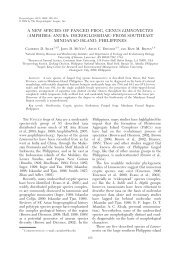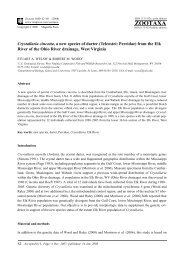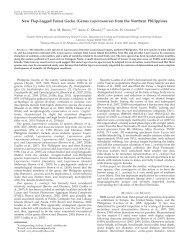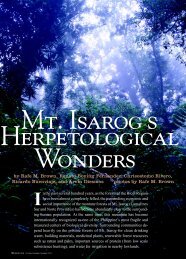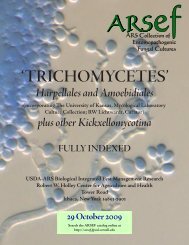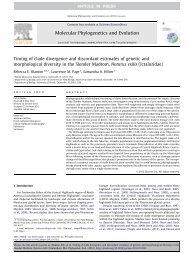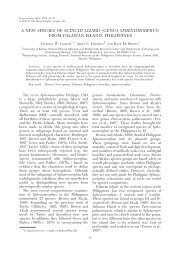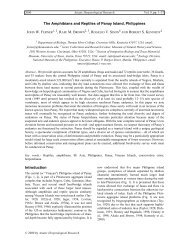(Percidae: Etheostoma), with Descriptions of Five New Species
(Percidae: Etheostoma), with Descriptions of Five New Species
(Percidae: Etheostoma), with Descriptions of Five New Species
- No tags were found...
You also want an ePaper? Increase the reach of your titles
YUMPU automatically turns print PDFs into web optimized ePapers that Google loves.
Bulletin 30 NOVEMBER 1, 2012developing tubercles on ventral body scales (vs. lacking);and breeding females having a long tubular genital papilla(vs. rugose, spatulate in Vaillantia and flat, bifurcatein Boleosoma). <strong>Species</strong> <strong>of</strong> Doration differ further in developinga pair <strong>of</strong> small dark spots on the base <strong>of</strong> the caudalfin (may be obscured in breeding males), a character alsorecognized by Douglas (1974) in E. stigmaeum. This pair<strong>of</strong> spots is a highly useful field character in distinguishingjuveniles and small adults <strong>of</strong> Doration from sympatric E.nigrum or E. chlorosoma, which develop a single irregularblotch. However, it is not useful in separating E. stigmaeumfrom E. davisoni, a species that also possesses two smallbasicaudal spots.<strong>Species</strong> <strong>of</strong> Doration differ further from those <strong>of</strong> Vaillantiaand Boleosoma in consistently having two anal spines(vs. 1 in some species). They differ further from species<strong>of</strong> Boleosoma in breeding males developing tubercles onpelvic and anal fin rays. They differ further from species<strong>of</strong> Vaillantia in preorbital bars not meeting at midline.Key to <strong>Species</strong> <strong>of</strong> Doration1. Premaxillary frenum present ........................... Go to 2Premaxillary frenum absent ............................ Go to 32. Anal fin s<strong>of</strong>t rays modally 9; cheek squamation 10–30%, usually 1–18 scales on upper cheek; caudal pedunclescales usually 17 or more; principal caudalfin rays 15........................................ <strong>Etheostoma</strong> jessiaeAnal fin s<strong>of</strong>t rays modally 8; cheek naked, occasionally<strong>with</strong> 1–3 scales behind eye; caudal pedunclescales usually 16; principal caudal fin rays <strong>of</strong>ten 16–17........................................................... <strong>Etheostoma</strong> meadiae3. Lateral line complete; cheeks fully scaled or nearly so;breeding male <strong>with</strong> continuous blue mask <strong>of</strong> pigmentcovering lower face, snout, and underside <strong>of</strong> head............................................................. <strong>Etheostoma</strong> akatuloLateral line usually incomplete, or if complete, cheeksnaked or nearly so; breeding male <strong>with</strong> blue pigment onhead but not as continuous mask...........................Go to 44. Unpored lateral scales usually 0–7 (0–13); principal caudalfin rays usually 16–17 (70% <strong>of</strong> specimens)........................................................................... <strong>Etheostoma</strong> meadiaeUnpored lateral scales usually >10 (0–28); principalcaudal fin rays 15............................................... Go to 55. Palatine teeth present (>85% <strong>of</strong> specimens); nape nakedto fully scaled; breeding male s<strong>of</strong>t dorsal and caudalfins lacking bright orange spots ................ Go to 6Palatine teeth absent (>70% <strong>of</strong> specimens); nape fullyscaled or nearly so; breeding male s<strong>of</strong>t dorsal and caudalfins <strong>with</strong> discrete, <strong>of</strong>ten bright, orange spots .................................................................................... Go to 76. Preoperculomandibular pores 10 (>75% <strong>of</strong> specimens);anal fin s<strong>of</strong>t rays modally 8; breeding malelacking thin dusky midlateral stripe running throughlateral blue-green bars ................ <strong>Etheostoma</strong> stigmaeumPreoperculomandibular pores 9 (>90% <strong>of</strong> specimens);anal fin s<strong>of</strong>t rays modally 9; breeding male <strong>with</strong> thindusky midlateral stripe running through lateral bluegreenblotches.................................... <strong>Etheostoma</strong> clinton7. Breeding male <strong>with</strong> base color <strong>of</strong> face gray <strong>with</strong>milky blue sheen, spinous dorsal fin lacking brightorange in basal band; scales below lateral line modally7; transverse scales modally 13 .................................................................................. <strong>Etheostoma</strong> teddyrooseveltBreeding male <strong>with</strong> base color <strong>of</strong> face tangerine orange,spinous dorsal fin <strong>with</strong> bright orange in basalband; scales below lateral line modally 6; transversescales modally 12 ............................................... Go to 88. Breeding male spinous dorsal fin <strong>with</strong> black submedialband, interrupted by orange streaks in posteriorportions <strong>of</strong> membranes; breeding male s<strong>of</strong>t dorsaland anal fins lacking basal blue pigment ..........................................................................<strong>Etheostoma</strong> jimmycarterBreeding male spinous dorsal fin <strong>with</strong> blue in submedialband, uninterrupted by orange streaks; breedingmale s<strong>of</strong>t dorsal and anal fins <strong>with</strong> basal blue pigment................................................................... Go to 99. Pectoral fin rays modally 15; scales above lateral linemodally 5; cheek squamation 10–30%, usually 2–15scales on upper cheek; s<strong>of</strong>t dorsal rays modally 12;breeding male anal fin lacking orange spots or <strong>with</strong>weak orange spots at distal edge <strong>of</strong> basal blue band.................................................................<strong>Etheostoma</strong> obamaPectoral fin rays modally 14; scales above lateral linemodally 4; cheek naked or nearly so, <strong>with</strong> usually 0–5scales behind eye; s<strong>of</strong>t dorsal rays modally 11; breedingmale anal fin <strong>with</strong> orange spots, usually 1–2 perray.............................................................<strong>Etheostoma</strong> gore<strong>Etheostoma</strong> stigmaeum (Jordan)Speckled DarterFigs. 3, 4Boleosoma stigmaeum Jordan, 1877:311 (original descriptionfrom small tributaries <strong>of</strong> Etowah and Oostanaula riversnear Rome, Floyd County, Georgia); Bailey et al., 1954:142 (designation <strong>of</strong> lectotype); Collette and Knapp, 1966:19 (location <strong>of</strong> lectotype and paralectotypes).Ulocentra stigmaea: Jordan and Brayton, 1878:45,82 (recordedfrom Alabama River basin; also known fromLouisiana); Jordan and Gilbert, 1883:495 (description;distributed from Georgia to Louisiana); Jordan and Evermann,1896:1047–1048 (description; distributed fromTennessee and Arkansas to Georgia and Louisiana);Fowler, 1907:522, fig. 5 (figure <strong>of</strong> syntype); Jordan, Evermann,and Clark, 1930:287 (distributed from Tennesseeand Arkansas to Georgia and Louisiana); Fowler, 1945:37,354–355, 369 (description; recorded from Alabama andMississippi river basins).


